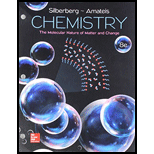
(a)
Interpretation:
The name of the ionic compound formed from potassium and sulfur is to be determined.
Concept introduction:
Ionic compounds are those compounds which are composed of ions. An ionic bond is formed when two ions of opposite charges combine due to the electrostatic forces of attraction. Ionic compounds are formed when a metal reacts with a non-metal. Metals have the tendency to lose electrons. Metals lose electrons to form cations whereas non-metals gain electrons to form anions. Cations and anions attract each other and form ionic compounds.
(b)
Interpretation:
The name of the ionic compound formed from iodine and barium is to be determined.
Concept introduction:
Ionic compounds are those compounds which are composed of ions. An ionic bond is formed when two ions of opposite charges combine due to the electrostatic forces of attraction. Ionic compounds are formed when a metal reacts with a non-metal. Metals have the tendency to lose electrons. Metals lose electrons to form cations whereas non-metals gain electrons to form anions. Cations and anions attract each other and form ionic compounds.
(c)
Interpretation:
The name of the ionic compound formed from nitrogen and cesium is to be determined.
Concept introduction:
Ionic compounds are those compounds which are composed of ions. An ionic bond is formed when two ions of opposite charges combine due to the electrostatic forces of attraction. Ionic compounds are formed when a metal reacts with a non-metal. Metals have the tendency to lose electrons. Metals lose electrons to form cations whereas non-metals gain electrons to form anions. Cations and anions attract each other and form ionic compounds.
(d)
Interpretation:
The name of the ionic compound formed from sodium and hydrogen is to be determined.
Concept introduction:
Ionic compounds are those compounds which are composed of ions. An ionic bond is formed when two ions of opposite charges combine due to the electrostatic forces of attraction. Ionic compounds are formed when a metal reacts with a non-metal. Metals have the tendency to lose electrons. Metals lose electrons to form cations whereas non-metals gain electrons to form anions. Cations and anions attract each other and form ionic compounds.
Want to see the full answer?
Check out a sample textbook solution
Chapter 2 Solutions
Loose Leaf for Chemistry: The Molecular Nature of Matter and Change
- Synthesize 2-Ethyl-3-methyloxirane from dimethyl(propyl)sulfonium iodide using the necessary organic or inorganic reagents. Draw the structures of the compounds.arrow_forwardSynthesize 2-Hydroxy-2-phenylacetonitrile from phenylmethanol using the necessary organic or inorganic reagents. Draw the structures of the compounds.arrow_forwardSynthesize N-Methylcyclohexylamine from cyclohexanol using the necessary organic or inorganic reagents. Draw the structures of the compounds.arrow_forward
- Synthesize N-Methylcyclohexylamine from cyclohexanol using the necessary organic or inorganic reagents. Draw the structures of the compounds.arrow_forwardIf possible, please provide the formula of the compound 3,3-dimethylbut-2-enal.arrow_forwardSynthesize 1,4-dibromobenzene from acetanilide (N-phenylacetamide) using the necessary organic or inorganic reagents. Draw the structures of the compounds.arrow_forward
- Indicate the products obtained by mixing (3-oxo-3-phenylpropyl)triphenylphosphonium bromide with sodium hydride.arrow_forwardWe mix N-ethyl-2-hexanamine with excess methyl iodide and followed by heating with aqueous Ag2O. Indicate the major products obtained.arrow_forwardIndicate the products obtained by mixing acetophenone with iodine and NaOH.arrow_forward
- Indicate the products obtained by mixing 2-Propanone and ethyllithium and performing a subsequent acid hydrolysis.arrow_forwardIndicate the products obtained if (E)-2-butenal and 3-oxo-butanenitrile are mixed with sodium ethoxide in ethanol.arrow_forwardQuestion 3 (4 points), Draw a full arrow-pushing mechanism for the following reaction Please draw all structures clearly. Note that this intramolecular cyclization is analogous to the mechanism for halohydrin formation. COH Br + HBr Brarrow_forward
 ChemistryChemistryISBN:9781305957404Author:Steven S. Zumdahl, Susan A. Zumdahl, Donald J. DeCostePublisher:Cengage Learning
ChemistryChemistryISBN:9781305957404Author:Steven S. Zumdahl, Susan A. Zumdahl, Donald J. DeCostePublisher:Cengage Learning ChemistryChemistryISBN:9781259911156Author:Raymond Chang Dr., Jason Overby ProfessorPublisher:McGraw-Hill Education
ChemistryChemistryISBN:9781259911156Author:Raymond Chang Dr., Jason Overby ProfessorPublisher:McGraw-Hill Education Principles of Instrumental AnalysisChemistryISBN:9781305577213Author:Douglas A. Skoog, F. James Holler, Stanley R. CrouchPublisher:Cengage Learning
Principles of Instrumental AnalysisChemistryISBN:9781305577213Author:Douglas A. Skoog, F. James Holler, Stanley R. CrouchPublisher:Cengage Learning Organic ChemistryChemistryISBN:9780078021558Author:Janice Gorzynski Smith Dr.Publisher:McGraw-Hill Education
Organic ChemistryChemistryISBN:9780078021558Author:Janice Gorzynski Smith Dr.Publisher:McGraw-Hill Education Chemistry: Principles and ReactionsChemistryISBN:9781305079373Author:William L. Masterton, Cecile N. HurleyPublisher:Cengage Learning
Chemistry: Principles and ReactionsChemistryISBN:9781305079373Author:William L. Masterton, Cecile N. HurleyPublisher:Cengage Learning Elementary Principles of Chemical Processes, Bind...ChemistryISBN:9781118431221Author:Richard M. Felder, Ronald W. Rousseau, Lisa G. BullardPublisher:WILEY
Elementary Principles of Chemical Processes, Bind...ChemistryISBN:9781118431221Author:Richard M. Felder, Ronald W. Rousseau, Lisa G. BullardPublisher:WILEY





